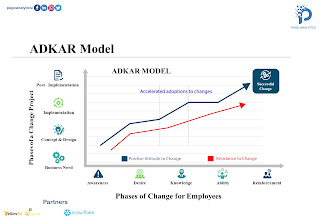ADKAR
Should I need to change my technology?
Will I need to work in Different Role than my current?
What if I need to work with different Manager!?
How my career will impact by this change?
We all face such questions and situations in work day to day
that require a change everyday life. Adjusting and welcoming the change become
more and more stress full in our brains and bring an anxiety, threat and
Fearfulness trigger.
We resist for these changes being a social animal and being
fallen to Habits, have one Image first and then these questions.
What Does ADKAR Stand For?
- Awareness
- Desire
- Knowledge
- Ability
- Reinforcement
As per the ADKAR
change management model, awareness and desire aim to move you out of the
current state, where change is needed but has not yet begun. Knowledge and
ability occur during the transition, and reinforcement focuses on the future.
How to Apply the ADKAR Model for Organizational Change
Because the ADKAR Model is
outcome-oriented, it can be used to facilitate change by setting clear
milestones to be reached throughout the process. For example, one person may
already have the desire to change, while another is still becoming aware of the
need to change. For instance, is someone unable to change because they do not
understand why it needs to happen (Awareness), or do they not understand how to
make the change (Knowledge)?
GOAL 1: Create
awareness of the need to change.
Without a doubt,
communicating the need for change is fundamental, but creating awareness for
the change goes beyond simply announcing it. In order for employees to be truly
aware of the necessity for change, they must not only understand the reasoning
behind it but also come to agree with that reasoning. Begin by providing clear
explanations of why the change is needed. Start by explaining that when
employees travel or work from home, it`s difficult for them to access documents
and communicate with the in-office team. In this case, SharePoint will allow
off-site workers to easily access documents and data.
GOAL 2: Foster
desire to make the change
Just because employees
understand why a change should be made doesn`t mean that they want that change.
Not only will your change leaders show public support for the change, but they
most naturally connect with the people who will be affected by it. Choose
change leaders who are able to relate to how daily routines will be affected so
that they can provide specific support and guidance. In order to foster desire,
change leaders need to get specific about the benefits of the change as they
apply to particular individuals or teams. You may want to replace three
separate tools with Salesforce because it saves you money, but that`s not a
great motivator for employees. When fostering desire, resistance to change is a
major obstacle. Resistance is to be expected, but you need to understand the
core reason for it. Once you understand the root cause of the resistance,
address it head-on and, if necessary, make adjustments to your change
implementation plan.
Goal 3:
Provide knowledge on how to change
In order to begin the
transition, your team will need to understand how their responsibilities,
skills, tools, and processes will be impacted. Given that everyone must reach
each milestone individually, knowledge-building needs to be specific. Provide
knowledge that applies directly to each team`s or individual`s
responsibilities. For example, if you are introducing new software, the IT team
may be responsible for setting everyone up to use it, while other departments
will need to focus more on how to use the software. Take time to evaluate what
additional skills, tools, and duties the change will require.
Goal 4: Ensure
that employees have the ability to make the change
The Prosci change
management methodology uses athletics to prove this point: While plenty of
baseball fans understand the mechanics behind throwing a curveball, not all of
them would make great pitchers. To bridge the gap between knowledge and
ability, change leaders in charge of coaching individuals or teams. Task change
leaders with collecting feedback from their teams and bringing potential issues
and obstacles to your attention. By giving teams a chance to test out the
change before fully rolling it out, you give them the opportunity to build
confidence.
Goal 5:
Reinforce the change
initial momentum may get
you to the finish line, but you won`t cross it if employees start relying on
old habits. Once new processes are in place, new software is installed, or the new
organizational chart is official, reinforce the change long after its
implementation. Zendesk`s Champagne Campaign, which involves setting small
goals for employees and then recognizing the success by placing a small bottle
of champagne on their desks The change process may be “complete,” but employee
feedback is still valuable. You should continue monitoring and reinforcing the
change all through Q4 if you intend to be fully switched over to SharePoint by
the end of Q3.



Comments
Post a Comment